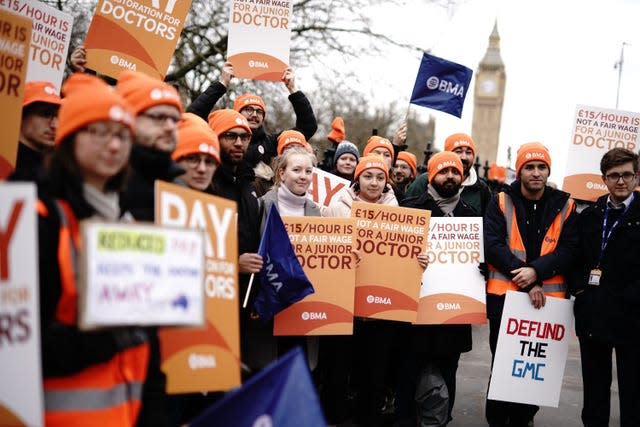Health leaders plan staff cuts amid ‘substantial’ saving targets, survey finds
The majority of health leaders are considering cutting clinical and non-clinical staff to balance their books, a new survey has found – with warnings this could hinder efforts to tackle NHS waiting lists.
Experts said strict targets are forcing services to take “drastic measures” and focus on short-term solutions rather than a long-term plan to bolster services.
One NHS boss also described their financial position as “very difficult” in the face of “extraordinary levels of demand”.
The survey of 110 health leaders by NHS Confederation included responses from bosses of NHS trusts, integrated care boards (ICBs), primary care services and voluntary organisations providing NHS services.
Some 67% of leaders from NHS trusts and ICBs said they are planning to let some clinical staff go to meet saving targets, with 90% saying they will reduce their non-clinical headcount.
In primary care, some 74% of leaders also said they will have to cut clinical staff, with 79% planning to let non-clinical staff go.
It comes after the Government announced an additional £2.5 billion for the NHS in 2024/25 as part of the spring budget in March.
At the time, NHS Confederation chief executive Matthew Taylor described the sum as “at best flat in real terms against a backdrop of significant deficits and universal pressures”.
The health service also has an annual efficiency – or cost savings – target of 2.2% for the period.
However, leaders told NHS Confederation that they would need to make savings of 6% for the year, with targets for local services ranging from 1.6% to 11%.
Mr Taylor said: “The NHS is operating under immense financial strain, with local services having to consider some drastic measures to balance their books this year.
“This will disrupt plans to improve patient care and reduce waiting lists.

“But it is also forcing NHS leaders to focus on delivering immediate cuts to achieve stringent efficiency targets over the long-term transformation of services that they want to be focusing on, we in fact, know this has already been happening in some trusts.
“Put simply, this is not an effective way to run local services.”
Prime Minister Rishi Sunak pledged to cut waiting lists in January 2023, although the figure continued to rise in the months that followed, reaching a record high in September before falling slightly.
The latest data from NHS England shows an estimated 7.54 million treatments were waiting to be carried out at the end of March 2024, relating to 6.29 million patients.
Health minister Andrew Stephenson said: “The Conservatives have taken bold action to cut waiting lists and secure the future of the NHS, with the total budget increasing by over a third in real terms since 2010 and our £2.4 billion long-term workforce plan – the first of its kind – delivering record numbers of doctors and nurses.
“Meanwhile Labour’s NHS spending commitments are completely unfunded, which would push up taxes on hard-working people and delay patients getting the care they need.
“Only Rishi Sunak and the Conservatives have a clear plan and will take the bold action necessary to cut waiting lists and deliver for patients. Sir Keir Starmer would put our progress at risk and take the country back to square one.”
Earlier this week, Sir Keir Starmer vowed that reducing the list would be the “first step” of a Labour government’s plans to get the NHS “back on its feet”.
Elsewhere, two thirds of trust and ICB leaders who responded to the survey said further strikes would also add to the pressure of meeting targets.
It comes after the British Medical Association (BMA) announced on Wednesday that junior doctors will walk out from 7am on June 27 until 7am on July 2, days before the General Election.
Overall, NHS strikes are estimated to have led to the cancellation of 1.4 million appointments and procedures, and have cost the health service about £3 billion.
The poll also revealed most leaders will deliver their budgets by freezing vacancies or slashing spending on agency locums or bank staff.
Figures from NHS Digital show there were 100,658 vacancies in England in the three months to March 2024.
Six in 10 NHS leaders also said they will need top-up funding from the Government within a year to hit targets, while six in 10 trust and ICB leaders said they could not meet their targets without more investment.
One NHS trust chair described its “financial position is really difficult” with the expectation of making “very substantial efficiency savings, larger than the NHS has ever achieved, at the same time as facing extraordinary levels of demand”.
An NHS chief executive also said they did not believe it was possible to deliver every financial, performance, workforce, quality and safety targets, adding “something has to give”.
Mr Taylor added: “While NHS leaders know they must continue to run their services as efficiently as possible, this is the tightest financial position the NHS has faced in years.
“This type of short-term planning hinders the NHS’s ability to plan services and it represents poor value for money for taxpayers.”
In February, NHS Confederation published a manifesto highlighting five key areas for the next government to prioritise.
These included a hike in NHS capital spending across the UK – with an increase of £6.4 billion for England alone – as well as a commitment to funding the NHS Long Term Workforce Plan and an equivalent blueprint for social care.
Mr Taylor said: “NHS productivity is being held back by reasons beyond the immediate gift of the NHS to control, such as insufficient capacity in social care and low levels capital investment.
“This is why we are calling on the next government to invest at least another £6.4 billion at the next Spending Review and a long-term funding and policy solution to the social care crisis.”


